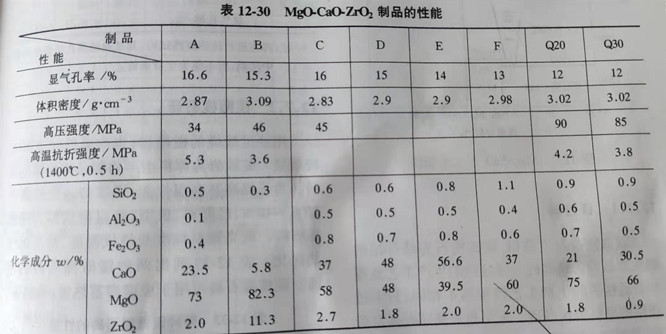Konite Product
One of the shortcomings of MgO-CaO material is poor thermal shock resistance. The effect of zirconium additive on thermal shock resistance of magnesia dolomite brick containing 31% CaO and 65% CaO content has been tested. The addition of zirconium additive is blank sample, S -1 is added powdered zirconia 2%, S - 2 is added granular zirconia 2%, S - 3 is calcium zirconate 4%, S - 4 is magnesium calcium zirconium compound 5%, All kinds of zirconia additives contain the same mass zirconia. The strength retention rate of the sample after thermal shock is investigated. The sample with 2% granular zirconia is the best. After 15 thermal shock cycles, the residual The residual strength can still be above 805 of the initial strength, and the order is as follows: S -2 > S - 3 > S - 4 > S - 1 > S. There was no obvious turning in the strength retention rate curve of the samples containing the first three additives, but there was an obvious drop in the strength relative values of the blank samples and the zirconia samples added with fine powder at the beginning of the thermal shock, which indicated that the two samples had great damage at the beginning of the thermal shock.
The addition of ZrO2 to magnesia dolomite brick (CaO content 25%) was carried out. When the manufacturing process is exactly the same, the thermal shock resistance (1100 ℃ ~ air cooling) of the products added with 2%ZrO2 is obviously improved, but the bending strength at high temperature decreases. According to the use environment, the type, particle size and amount of ZrO2 additions should be determined in order to obtain the appropriate price-to-price ratio of the products. Table 12 - 30 shows the properties of several MgO-CaO-ZrO2 products for cement kilns.

Stable Dolomite Brick
Stable dolomite clinker was prepared by adding proper amount of apatite stabilizer and iron oxide sintering agent with dolomite and serpentine as raw materials. All kinds of bulk raw materials were broken to 5 mm, accurately weighed according to the determined ratio, mixed with ball mill and ground until the particle size was less than 0.088 mm. Add proper amount of water or sulfite pulp waste liquid to the ground powder, fully mix, and press the waste billet with friction brick press. Stable dolomite clinker was prepared by calcination at 1500 ℃ after drying. The clinker is broken again, crushed into particles, part of which is ground into fine powder, proportioned according to the best gradation, and sulfite pulp waste liquor is used as binder. According to a certain feeding order, the brick is mixed evenly in the wet mill and formed by friction brick pressing machine. after wet curing for a certain time, the brick billet is dried until the moisture is less than 0.5%, and the stable dolomite brick is sintered at 1400 ℃. The main points of the process are as follows: (1) the dolomite raw materials used should be as pure as possible, requiring the ratio of Al2O3 to Fe2O3 is less than 0.64, Fe2O3 is less than 3.5%, especially the content of Al2O3 should be as low as possible. (2) silica, talc, serpentine and forsterite are usually used as raw materials to bring SiO2. Serpentine and forsterite with high MgO content are among them. It's better. The addition of SiO2 compounds is usually determined according to the lime saturation coefficient kH=0.95~1.00. (3) the addition of phosphate lime stabilizer can prevent the transformation of C2S crystal form, and the P2O5 content is about 1%.
MgO-SiO2 products
Table12-7 are phase diagrams of the MgO-SiO2 binary system. There are two compounds in the phase diagram: the forsterite (M2S) is a orthosilicate, a congruent melting compound. The liquid-phase line at its highest temperature (1890 ℃) is in a sharp shape, indicating that it is difficult to dissociate at high temperature. So it is a kind of mineral phase with high melting point and stable structure. It is a good ceramic and refractory material. The clinopyroxene (MS) is a metasilicate, which is a non-consistent melting compound. It is a kind of mineral phase with low melting point, easy to melt and decompose and the structure is not stable. It is not suitable to be used as a refractory material, in the form of magnesian, olivine, Refractory is a harmful component, I hope to avoid it as much as possible.


